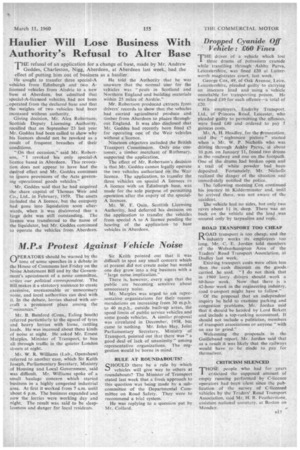M.P.s Protest Against Vehicle Noise
Page 49

If you've noticed an error in this article please click here to report it so we can fix it.
QPERATORS should be warned by the tone of some speeches in a debate in the House of Commons last Friday on the Noise Abatement Bill and by the Government's apointment of a noise committee, writes ow. political cbrrespondent. The Bill makes it a statutory nuisance to create excessive, unreasonable or unnecessary noise, and local authorities can deal with it. In the debate, lorries shared with aircraft a prominent place among the "nuisances."
Mr. B. Batsford (Cons., Ealing South) referred particularly to the squeal of tyres and heavy lorries with loose, rattling loads. He was incensed about these kinds of noise at night. He asked Mr. Ernest Marples. Minister of Transport, to ban all through traffic in the quieter London streets at night.
Mr. W. R. Williams (Lab., Openshaw) referred to another case, which Sir Keith Joseph, Parliamentary Secretary, Ministry of Housing and Local Government, said was difficult. Mr. Williams spoke of a small haulage concern which started business in a highly congested industrial area. At first it worked from 7 a.m. until about 6 p.m. The business expanded and now the lorries were working day and night. The result was said to be sleeplessness and danger for local residents.
Sir Keith pointed out that it was difficult to spot any small concern which at present did not create noise but would one day grow into a big business with a " large noise implication."
There is, however, every sign that the public are becoming sensitive about unnecessary noise.
Mr. Marples was urged to ask representative organizations for their recommendations on increasing from 30 m.p.h. to 40 m.p.h., outside built-up areas, the speed limits of public service vehicles and some goods vehicles. A similar proposal was circulated in December, 1958, but came to nothing. Mr. John Hay, Joint Parliamentary Secretary, Ministry of Transport, pointed out that there was 'a good deal of lack of unanimity" among representative organizations. The suggestion would be borne in mind. "
RULE AT ROUNDABOUTS? gHOULD there be a rule by which vehicles will give way to others at roundabouts? The Minister of Transport stated last week that a fresh approach to this question was being made by a subcommittee of the Departmental Committee on Road Safety. They were to recommend a trial system.
He was replying to a question put by Mr. Collard.




































































































































